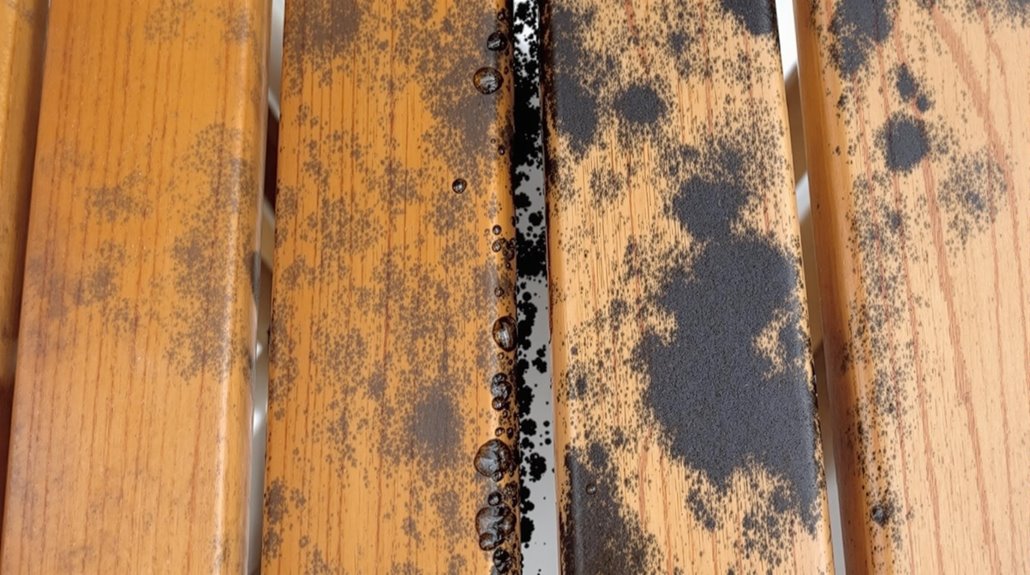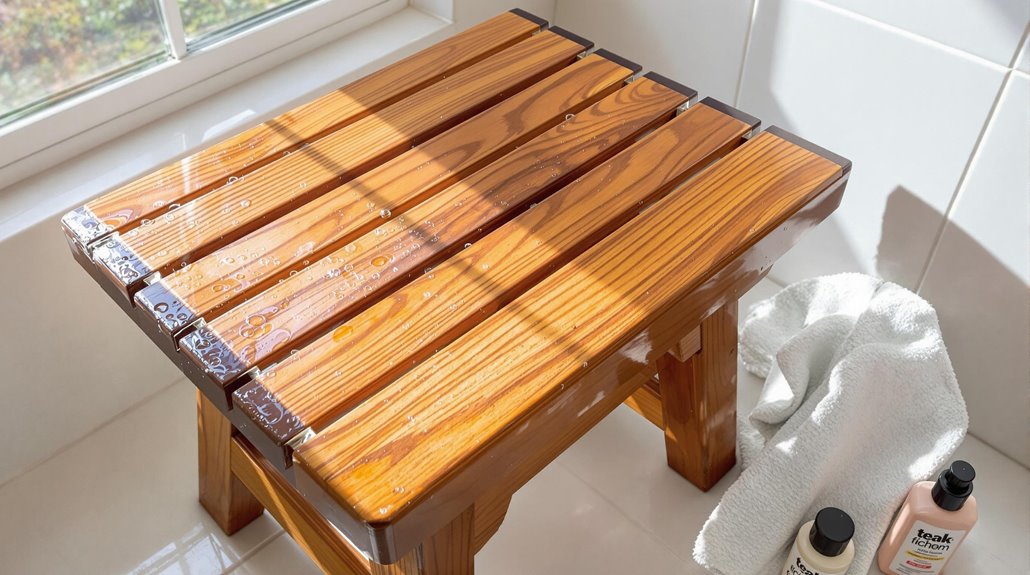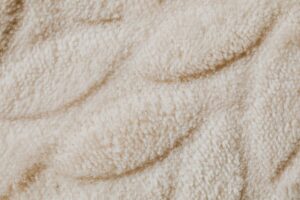Picture your beautiful teak shower stool slowly deteriorating from mold and mildew – it’s a common problem I’ve faced with my own bathroom furniture. I’ve learned that keeping teak furniture clean and mold-free isn’t just about occasional scrubbing; it requires a strategic approach combining proper cleaning techniques and preventive maintenance. Through years of trial and error, I’ve discovered the most effective methods that’ll help you protect your investment and extend its lifespan.
Understanding Mold Growth on Teak Shower Furniture

While teak is naturally resistant to moisture, it’s still vulnerable to mold growth when exposed to the constant humidity of your shower environment.
I’ve found that mold typically starts growing in the crevices and joints of teak furniture, especially where water can pool and stagnate.
Despite teak’s impressive durability, I want you to understand that mold prevention requires regular maintenance and proper airflow.
When I inspect shower stools, I often notice black or green spots forming on the underside first, where ventilation is poorest.
You’ll need to pay special attention to these hidden areas, as they’re most likely to develop problems.
I recommend lifting your stool between uses to let air circulate underneath, which helps maintain the wood’s natural resistance to fungal growth.
Essential Cleaning Supplies and Tools
Proper teak cleaning starts with gathering the right supplies, and I’ve found that having everything ready makes the job much simpler.
Before you begin cleaning your teak shower stool, I recommend organizing your essential supplies and cleaning tools in one accessible spot near your work area.
- Soft-bristled brush or non-metallic scrubbing pad to avoid scratching the wood
- Mild teak cleaner or a mixture of gentle dish soap and warm water
- Clean microfiber cloths or soft cotton rags for drying
- Rubber gloves to protect your hands from cleaning solutions
- Spray bottle for applying cleaning solution evenly
I always make certain to keep these items separate from harsh bathroom cleaners, as strong chemicals can damage teak’s natural oils and protective properties.
Having the right tools ready guarantees you’ll clean your stool safely and effectively.
Step-by-Step Deep Cleaning Process
The deep cleaning process for your teak shower stool follows five essential steps that I’ll walk you through in detail.
First, I’ll have you rinse the stool thoroughly with warm water to remove surface debris and soap residue.
Next, using gentle cleaning techniques, apply a mixture of mild soap and water with a soft-bristled brush, scrubbing in the direction of the wood grain.
For stubborn stains or mildew, I recommend creating a paste with baking soda and water, letting it sit for 10 minutes.
After cleaning, rinse everything completely – this is vital for proper teak care.
Finally, let your stool air dry in a well-ventilated space, away from direct sunlight, which I’ve found helps prevent warping and maintains the wood’s natural oils.
Natural Cleaning Solutions for Teak Wood

Since teak wood responds beautifully to natural cleaning solutions, I’ve found several eco-friendly options that work wonders for routine maintenance.
When you’re looking to clean your teak shower stool safely, I recommend using gentle ingredients from your kitchen instead of harsh chemicals.
- Mix equal parts white vinegar solution and warm water for a natural disinfectant that won’t damage the wood’s oils.
- Create a paste using baking soda and water to tackle tough stains without scratching.
- Use freshly squeezed lemon juice to naturally brighten the wood while killing bacteria.
- Apply a light coat of food-grade mineral oil or teak oil after cleaning to maintain moisture resistance.
- Make a gentle scrub with coarse salt and water for deep cleaning without chemicals.
Preventive Maintenance Tips and Schedule
Regular maintenance of your teak shower stool doesn’t need to be complicated, but I’ve learned that following a consistent care schedule will extend its life considerably.
I recommend implementing these preventive measures after each shower: wipe down the stool with a clean, dry cloth and leave it in a well-ventilated area to dry completely.
For your maintenance schedule, I suggest a weekly cleaning with mild soap and water, followed by thorough drying.
Every month, I want you to inspect the stool for any signs of mold, mildew, or water damage, particularly in the joints and corners.
Every six months, apply a thin coat of teak oil to protect the wood and maintain its natural beauty.
Restoring Weathered or Moldy Teak
Despite your best maintenance efforts, teak shower stools can sometimes develop signs of weathering or mold growth that require more intensive restoration.
I’ve found that restoring weathered teak involves careful surface sanding followed by thorough teak oiling to bring back that warm, golden glow.
- Start with medium-grit sandpaper (120-150) to remove surface damage and gray patches
- Sand in the direction of the wood grain to avoid creating scratches
- Clean off all dust with a tack cloth before applying teak oil
- Apply thin coats of teak oil using a lint-free cloth, allowing each coat to dry
- Test a small area first to verify there’s no adverse reaction with the wood
Once you’ve completed the restoration process, your teak shower stool should look rejuvenated and be ready for regular use again.
Best Practices for Long-Term Teak Protection

While maintaining a teak shower stool might seem challenging, I’ve found that following a few key protection practices can keep it looking beautiful for years to come.
I recommend applying a high-quality teak oil every 2-3 months to maintain the wood’s natural moisture barrier and prevent water damage.
For shower stools that sit near windows, I always suggest positioning them away from direct sunlight or applying a UV-protective finish to prevent fading and discoloration.
I make sure to keep my stool elevated on non-slip feet when not in use, allowing proper air circulation underneath.
Additionally, I’ve learned that quick-drying the stool with a microfiber cloth after each use helps prevent water from seeping into the grain, extending its lifespan considerably.







